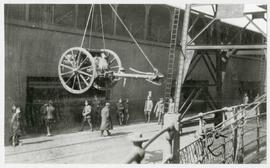The Nuclear Age archive consists of typescript transmission scripts, interview transcripts and videotapes concerning the development of nuclear technology and strategy from 1938 to 1989. It includes twelve typescript transmission scripts and VHS (Vertical Helix Scan) videotapes for episodes 1-12, Jan-Mar 1989, and 267 typescript transcripts of interviews with 195 individuals, prominent in the political, diplomatic, scientific and military aspects of the development and deployment of nuclear technology, from the USA, USSR, UK, Federal Republic of Germany, Israel, Japan, India, Pakistan and the People's Republic of China, 1938-1989, notably including Professor Georgiy Arkadevich Arbatov, Soviet Academy of Sciences, 1974-[1989]; Professor Hans Albrecht Bethe, Professor of Theoretical Physics, Cornell University, Ithaca, New York, USA, 1937-1975; Dr Norris Edwin Bradbury, Director, Los Alamos Scientific Laboratory, New Mexico, USA, 1945-1970; Dr Harold Brown, Director, Lawrence Livermore National Laboratory, University of California, Livermore, California, USA, 1960-1961; Zbigniew (Kasimierz) Brzezinski, US National Security Advisor, 1977-1981; James Earl 'Jimmy' Carter, US President, 1977-1981; Rt Hon Denis Winston Healey, Secretary of State for Defence, 1964-1970; Rt Hon Michael Ray Dibdin Heseltine, Secretary of State for Defence, 1983-1986; Dr Henry (Alfred) Kissinger, US Secretary of State, 1973-1977; Andrei Afanasevich Kokoshin, First Deputy Minister of Defence, Russian Soviet Federal Socialist Republic (RSFSR), 1992-1997; Robert Strange McNamara, US Secretary of Defense, 1961-1968; Professor Philip Morrison, Physicist, Metallurgy Laboratory, University of Chicago, Chicago, Illinois, USA, 1943-1944; Paul Henry Nitze, Head of the US INF (Intermediate-range Nuclear Forces) negotiations, 1981-1984; Rt Hon Sir John (William Frederic) Nott, Secretary of State for Defence, 1981-1983; Professor Sir Rudolf (Ernst) Peierls, Professor of Mathematics and Physics, University of Bern, Switzerland, 1937-1963; Professor Isidor Isaac Rabi, Professor of Physics, Columbia University, New York, USA, 1937-1967; Lt Gen Yitzhak Rabin, Israeli Prime Minister, 1974-1977; Professor Joseph Rotblat, Director of Research in Nuclear Physics, University of Liverpool, 1945-1949; (David) Dean Rusk, US Secretary of State, 1961-1969; James Rodney Schlesinger, US Secretary of Defense, 1973-1975; Helmut (Heinrich Waldemar) Schmidt, Chancellor, Federal Republic of Germany, 1974-1982; Professor Edward Teller, Director, Lawrence Livermore National Laboratory, University of California, USA, 1960-1975; Cyrus Roberts Vance, US Secretary of State, 1977-1980; Professor Evgeny Pavlovich Velikhov, Soviet Kurchatov Institute of Atomic Energy, 1961-1984, and Professor of Nuclear Physics, Moscow State University, 1973-1986; Caspar Willard Weinberger, US Secretary of Defense, 1981-1987; Professor Victor Frederick Weisskopf, Professor of Physics, Massachusetts Institute of Technology, Cambridge, Massachusetts, USA, 1946-1960; Professor Freiherr Carl Friedrich von Weizsäcker, Head of Department, Max Planck Institute for Physics, Göttingen, Federal Republic of Germany, 1946-1957; Rt Hon George Kenneth Hotson Younger, Secretary of State for Defence, 1986-1989; Solly Zuckerman, Baron Zuckerman of Burnham Thorpe, Norfolk, Chief Science Adviser to the Secretary of State for Defence, 1960-1966, and Chief Science Adviser to HM Government, 1964-1971.
Central Independent Television and WGBH Boston.


